Good Monday morning and welcome back. Politics in D.C., China, BREXIT plans, and France are in the news this morning. The good news on this first day of May is that the U.S. Government will not be at risk of shutting down (well, until the end of September, that is), as House and Senate negotiators appear to have reached a bipartisan deal on a $1.16 trillion spending bill. The vote on the bill could be held mid-week. In other news, China's primary gauge of factory production came in short of expectations. China's Manufacturing PMI came in 51.2 in April, which was down from March's 51.8 (an almost 5-year high) and below the estimates for a reading of 51.7. The services PMI also fell, coming in at a 6-month low of 55.1. (Recall that readings over 50 indicate expansion and below 50, contraction.) Next, the EU summit in Brussels ended with U.K. PM Theresa May's expectations for post-BREXIT trade being referred to as unrealistic. And lest we forget, France's Presidential run-off election is just 6 days away. And so far at least, markets appear to be none the worse for wear to start the week.
Now let's move on to an objective review the key market models and indicators. The primary goal of this exercise is to remove any preconceived, subjective notions about the markets and ensure that we stay in line with what "is" really happening in the market. So, let's get started...
The State of the Trend
We start each week with a look at the "state of the trend." These indicators are designed to give us a feel for the overall health of the current short- and intermediate-term trend models.
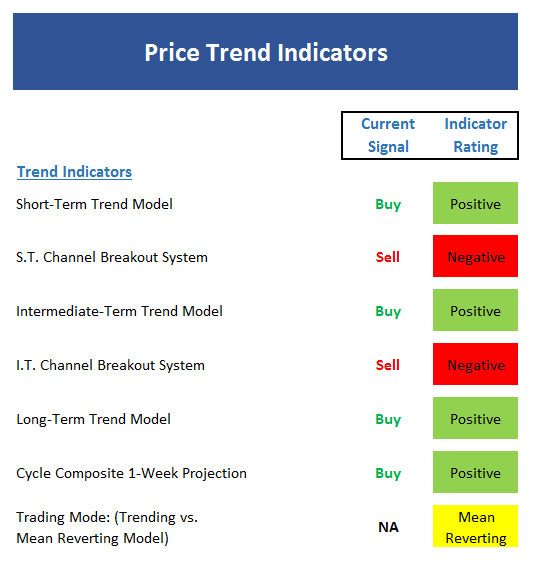
Executive Summary:
- The short-term Trend Model is back to positive as price is above its moving averages and the moving averages are themselves moving higher
- With stocks in a mean-reverting mode at this time, the short-term Channel Breakout System becomes more sensitive and has flipped to a sell signal
- The intermediate-term Trend Model is back to positive (but still rangebound)
- Due to the trading mode, the intermediate-term Channel Breakout System has also flipped to a sell
- The long-term Trend Model remains solidly positive
- The Cycle Composite points higher again this week
- Two of the three Trading Mode models are in mean-reverting mode at this time
The State of Internal Momentum
Next up are the momentum indicators, which are designed to tell us whether there is any "oomph" behind the current trend...
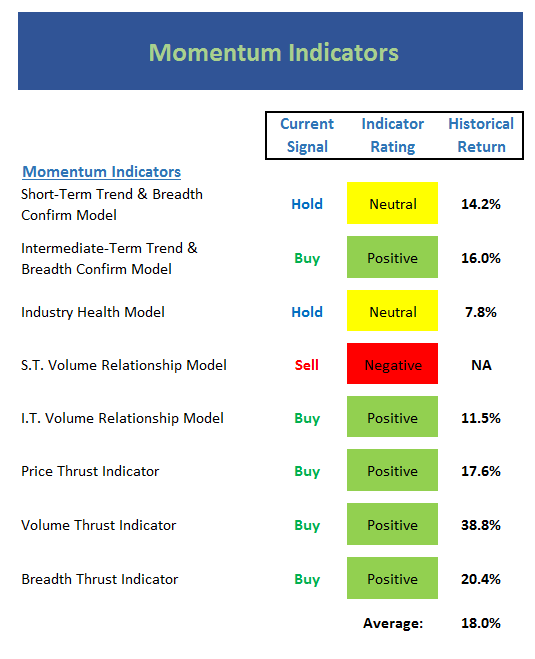
Executive Summary:
- Our short-term Trend and Breadth Confirm Model slipped into the neutral zone at the end of the week, albeit by a very small margin
- Our intermediate-term Trend and Breadth Confirm Model remains positive
- The Industry Health Model remains stuck in neutral and going nowhere fast. This is an indication of the market's narrow leadership.
- The short-term Volume Relationship came very close to turning positive and then fell back into negative zone late in the week
- The intermediate-term Volume Relationship remains solidly positive
- The Price Thrust Indicator remains green
- The Volume Thrust Indicator edged into positive zone where stocks have advanced smartly over time
- The Breadth Thrust Indicator also managed to move up into the positive zone
- The takeaway here is we saw some technical improvement last week
The State of the "Trade"
We also focus each week on the "early warning" board, which is designed to indicate when traders may start to "go the other way" -- for a trade.
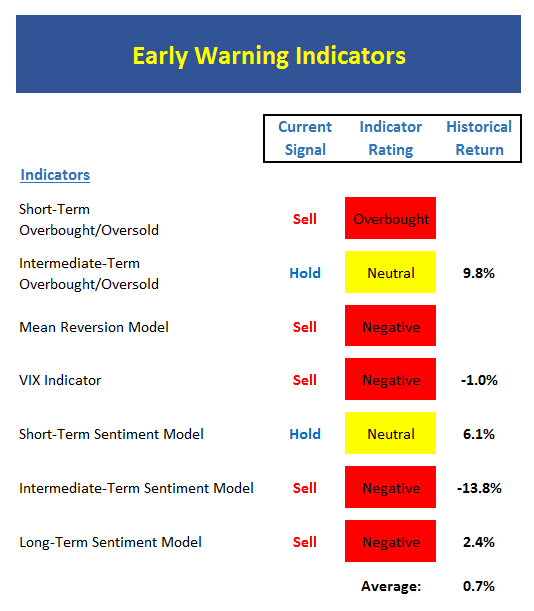
Executive Summary:
- From a near-term perspective, stocks are overbought. The key is whether or not this condition can remain in place.
- From an intermediate-term view, stocks are have worked off the oversold condition and are now neutral.
- The Mean Reversion Model has flashed a sell signal at the end of the week.
- Both the short- and intermediate-term VIX Indicators have flashed sell signals in the last week
- From a short-term perspective, market sentiment is back to neutral.
- The intermediate-term Sentiment Model has slipped to negative
- Longer-term Sentiment readings remain overly optimistic - a negative
The State of the Macro Picture
Now let's move on to the market's "external factors" - the indicators designed to tell us the state of the big-picture market drivers including monetary conditions, the economy, inflation, and valuations.
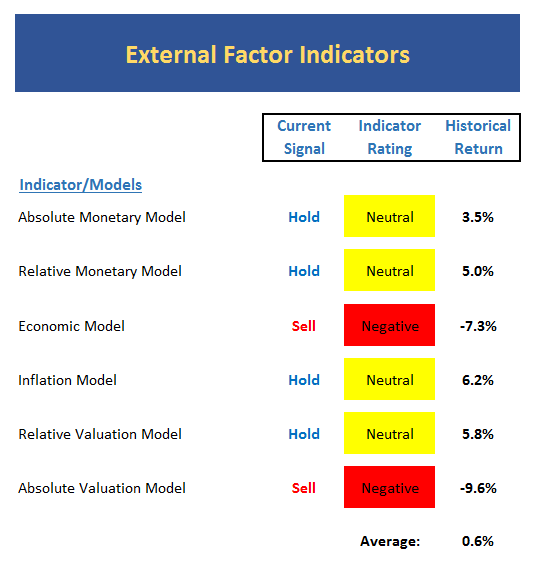
Executive Summary:
- Absolute Monetary conditions continue to fall within the lower reaches of the neutral zone
- On a relative basis, our Monetary Models continue to improve slightly as rates remain near the lows for the calendar year
- Our Economic Model (designed to call the stock market) has been out of sync but is showing signs of improvement
- The Inflation Model has continued to pull back, suggesting the surge in inflationary pressures is waning
- Our Relative Valuation Model continues to slip within the neutral zone
- The Absolute Valuation Model remains wildly overvalued
The State of the Big-Picture Market Models
Finally, let's review our favorite big-picture market models, which are designed to tell us which team is in control of the prevailing major trend.
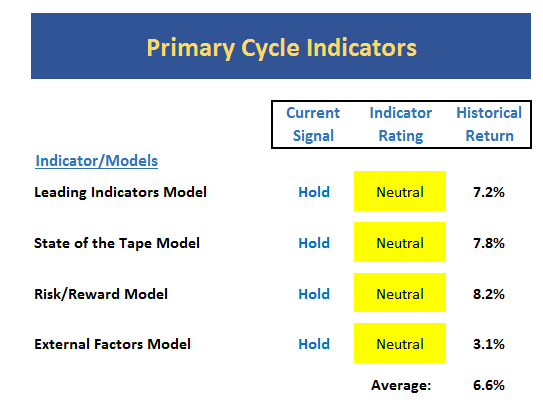
Executive Summary:
- The Leading Indicators model, which did a fine job during the last bear phase, remains neutral and on a sell signal.
- The broad market tape remains neutral at this time
- The Risk/Reward model continues to suggest that some caution is warranted
- The External Factors model has seen improvement but remains neutral
The Takeaway...
With the models sending conflicting signals here (trend and momentum are fairly upbeat while external factors are negative), my takeaway is that despite the NASDAQ stepping lively to new highs and the rest of the major indices within spitting distance of fresh record levels, (a) this is NOT a low risk environment and (b) we could be seeing the beginning of a "blowoff" phase. So, while it is likely okay to continue to ride on the bull train, risk management could become important at some time this year.
Thought For The Day:
Sometimes you have to forget what's gone, appreciate what remains, and look forward to what's coming next.
Current Market Drivers
We strive to identify the driving forces behind the market action on a daily basis. The thinking is that if we can both identify and understand why stocks are doing what they are doing on a short-term basis; we are not likely to be surprised/blind-sided by a big move. Listed below are what we believe to be the driving forces of the current market (Listed in order of importance).
1. The State of Geopolitical Issues
2. The State of Earning Season
3. The State of Trump Administration Policies
4. The State of the U.S. Economy
Wishing you green screens and all the best for a great day,

David D. Moenning
Chief Investment Officer
Sowell Management Services
Looking for a "Modern" approach to Asset Allocation and Portfolio Design?
Looking for More on the State of the Markets?
Investment Pros: Looking to modernize your asset allocations, add risk management to client portfolios, or outsource portfolio Management? Contact Eric@SowellManagement.com
Disclosures
The opinions and forecasts expressed herein are those of Mr. David Moenning and may not actually come to pass. Mr. Moenning's opinions and viewpoints regarding the future of the markets should not be construed as recommendations. The analysis and information in this report is for informational purposes only. No part of the material presented in this report is intended as an investment recommendation or investment advice. Neither the information nor any opinion expressed constitutes a solicitation to purchase or sell securities or any investment program.
Any investment decisions must in all cases be made by the reader or by his or her investment adviser. Do NOT ever purchase any security without doing sufficient research. There is no guarantee that the investment objectives outlined will actually come to pass. All opinions expressed herein are subject to change without notice. Neither the editor, employees, nor any of their affiliates shall have any liability for any loss sustained by anyone who has relied on the information provided.
The analysis provided is based on both technical and fundamental research and is provided "as is" without warranty of any kind, either expressed or implied. Although the information contained is derived from sources which are believed to be reliable, they cannot be guaranteed.
David D. Moenning is an investment adviser representative of Sowell Management Services, a registered investment advisor. For a complete description of investment risks, fees and services, review the firm brochure (ADV Part 2) which is available by contacting Sowell. Sowell is not registered as a broker-dealer.
Employees and affiliates of Sowell may at times have positions in the securities referred to and may make purchases or sales of these securities while publications are in circulation. Positions may change at any time.
Investments in equities carry an inherent element of risk including the potential for significant loss of principal. Past performance is not an indication of future results.
Advisory services are offered through Sowell Management Services.
Recent free content from FrontRange Trading Co.
-
 Is The Bull Argument Too Easy These Days?
— 8/31/20
Is The Bull Argument Too Easy These Days?
— 8/31/20
-
 What Do The Cycles Say About 2020?
— 1/21/20
What Do The Cycles Say About 2020?
— 1/21/20
-
 Modeling 2020 Expectations (Just For Fun)
— 1/13/20
Modeling 2020 Expectations (Just For Fun)
— 1/13/20
-
 Tips From Real-World Wendy Rhoades
— 5/06/19
Tips From Real-World Wendy Rhoades
— 5/06/19
-
 The Best Recession Ever!
— 4/29/19
The Best Recession Ever!
— 4/29/19
-
{[comment.author.username]} {[comment.author.username]} — Marketfy Staff — Maven — Member


